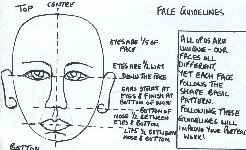|
|
Anna Esteban, Llicència d'estudis a St Helens, 2005-06 |
| Sessions |
Two
|
|
| Focus |
Draw portraits
Line, shape, tone, colour and texture To develop the ability to use different qualities of line to express throughout feelings. |
|
| Material |
Drawing pencils, soft graphite
pencils, (2B-4B), charcoal,
coloured pencils, wax crayons Chalk pastels, including white and black, art paper mirrors |
|
| Resources |
Book:
Art 4, Step by
Step Webs: Maddison Middle School Fine print on canvas |
|
| Talk about |
The difference between a portraits and self-portraits.
Looking carefully at the proportions of a head: The face if is oval, symmetrical, The eyes are in the centre and the nose in half way between the eyes and the chin. The mouth is half-way between nose and chin. The top of the ears are level with the eyes and the bottom level with the base of the nose. Look at portraits of other artists and children portraits to see if they have used the pointers |
|
| Sketchbook |
Draw
several ovals, eyes, mouth, noses.
Cut eyes, mouth, noses from magazines and place them in a correct position and draw additional features to complete each portrait. |
|
|
Doing |
Trace the shape of their face with your finger only on the piece of paper to see if it will fit. Lightly sketch in the shape of the head, the neck and the shoulders. Then sketch the eyes, nose, mouth...carefully placing them in the right position. Now you are ready to add detail by looking for shadows, lines, curves and texture. They may want to experiment with shading, lining using colours. List the colours you will need before starting. |
 |
|
Developing the idea |
|
|
| Vocabulary and language |
Portrait, Self Portrait
Shade, Parts of the face Descriptive expressions: happy, sad, upset.. Shapes: long, oval, curvy Colour: bright, dull, light, dark Line: thin, feint, wavy, broken. Tone Textures: smooth, rough Composition: figure, pose, expression, gesture, character. |
|
|
Assessment |
- To review what they and the others have done and say what they think and feel about it, using descriptive vocabulary. - To identify what they might change in the current work or develop in future work. - To feedback Why they like a particular picture, the hair, glasses, if it looks as him/her, smile, darks and lights... - From the artists portraits, how different are ones from others.
|
|